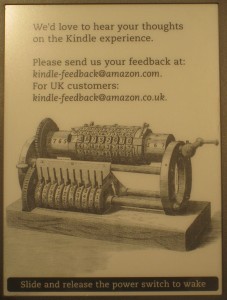 National Public Radio runs a show called “The Story.” Tonight’s story (listen here) was about a group of three well-known musicians (Amanda Palmer, Ben Folds of TV’s Sing-Off, and Damian Kulash of OK-Go), a famous writer/lyricist (Neil Gaiman) and a producer (Sean Slade) who decided to try an experiment this past April. They wanted to see if it was possible to produce a music album of eight original songs in eight hours, completely from scratch. They called the project, “Eight in Eight” and the album they produced is called “Nighty Night.”
National Public Radio runs a show called “The Story.” Tonight’s story (listen here) was about a group of three well-known musicians (Amanda Palmer, Ben Folds of TV’s Sing-Off, and Damian Kulash of OK-Go), a famous writer/lyricist (Neil Gaiman) and a producer (Sean Slade) who decided to try an experiment this past April. They wanted to see if it was possible to produce a music album of eight original songs in eight hours, completely from scratch. They called the project, “Eight in Eight” and the album they produced is called “Nighty Night.”
The group didn’t quite meet their ambitious goal. After 12 hours, they stopped with only six songs under their belts — an impressive feat, nonetheless. Continue reading The Power of Self-Imposed, Extremely Tight Deadlines →
The thousands of developers at the Nationwide family of insurance companies are exemplary practitioners of agile software development. They are led by Tom Paider, who uses a list that he calls the “21 Agile Tea Leaves” to measure how well any one team is doing.
- Whole Team
- Open Workspace
- Daily Standup Meetings
- Big Visible Charts
- Retrospectives
- Customer Collaboration
- Collective Code Ownership
- Simple & Evolutionary Design
- Test Driven Development
- Refactoring
- Continuous Integration
- Automated Regression Tests
- Technical Debt
- Pair Programming
- Sustainable Pace
- Iterations/Sprints
- Iteration Planning Meetings
- Show & Tells
- Frequent Releases
- Release Planning Meetings
- Story Cards w/Acceptance Criteria
Previously, I posted what I called an Agile Dependencies Chart. These two documents are remarkably similar in content. Other than the obvious fact that
Here are the slides (as a PDF file) for the Intro to Test-Driven Development speech that I gave at the SCQAA meeting last night. I haven’t seen the speaker feedback forms yet, but based on the comments from people walking up to me afterwards, it was an effective speech. In particular, everyone loved my grand experiment to demonstrate TDD — without requiring any programming knowledge — by having the audience break up into teams and write limericks test-driven.
If enjoyed this speech, then you might also be interested in materials from other speeches that I’ve given in the past. You can find them on the Downloads page.
The S in the INVEST mnemonic is a reminder to make your user-stories small. The trick is in knowing how small is small enough. The rule here is to make the story as small as possible, yet that it retains some measurable amount of intrinsic value — something that, when demonstrated to the end users, they’ll agree is an improvement to the system. Conversely, Continue reading User-Story Sizing: How Small is Small Enough? →
 I’m often asked if I have any good user-story examples to share. Until recently, I always had to answer, “No,” because I didn’t have permission from my clients to share their work product. Then, the other day, it occurred to me that I could kill two birds with one stone. As an avid user of Amazon’s Kindle e-reader, I had some feedback to share with Amazon — feedback that I hope might improve the already excellent product. I decided to write up my feedback in the form of user-stories, complete with acceptance criteria. Below, therefore, you will find four new-feature stories and one bug-report story, each with three or four acceptance-test scenarios.
I’m often asked if I have any good user-story examples to share. Until recently, I always had to answer, “No,” because I didn’t have permission from my clients to share their work product. Then, the other day, it occurred to me that I could kill two birds with one stone. As an avid user of Amazon’s Kindle e-reader, I had some feedback to share with Amazon — feedback that I hope might improve the already excellent product. I decided to write up my feedback in the form of user-stories, complete with acceptance criteria. Below, therefore, you will find four new-feature stories and one bug-report story, each with three or four acceptance-test scenarios.
I did this partially just as a mental exercise, but I also reasoned that Continue reading Some User-Story Examples →
a blog by Craig L. Jones, Software Agilist
 National Public Radio runs a show called “The Story.” Tonight’s story (listen here) was about a group of three well-known musicians (Amanda Palmer, Ben Folds of TV’s Sing-Off, and Damian Kulash of OK-Go), a famous writer/lyricist (Neil Gaiman) and a producer (Sean Slade) who decided to try an experiment this past April. They wanted to see if it was possible to produce a music album of eight original songs in eight hours, completely from scratch. They called the project, “Eight in Eight” and the album they produced is called “Nighty Night.”
National Public Radio runs a show called “The Story.” Tonight’s story (listen here) was about a group of three well-known musicians (Amanda Palmer, Ben Folds of TV’s Sing-Off, and Damian Kulash of OK-Go), a famous writer/lyricist (Neil Gaiman) and a producer (Sean Slade) who decided to try an experiment this past April. They wanted to see if it was possible to produce a music album of eight original songs in eight hours, completely from scratch. They called the project, “Eight in Eight” and the album they produced is called “Nighty Night.”